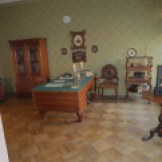Back home again, and still scrapbooking our trip to Russia … I’ve had time to reflect and share my thoughts about it all. While Aussie tourists have been ubiquitous on all our previous travels, in Russia we found ourselves exotic. ‘From Avstralia’, they would say in delighted astonishment, ‘a long way!‘
Well, yes, of course it is, but Australia is a long way away from everywhere and the long-haul flight to Moscow isn’t much different to a long-haul flight to London or Paris or Rome. The tyranny of distance doesn’t explain why so few of us venture to Russia. So, here are my Ten Best Things about Russia to entice you!
1. Visiting Russia will clear your head of all those obsolete grey Cold War preconceptions that you have from the movies. Moscow is a dynamic, exciting city full of interesting things to see; St Petersburg is one of the most beautiful cities in the world.
2. Russia is a booklovers’ paradise. They are justifiably proud of their literary heritage and visiting the homes of Tolstoy, Chekhov and Dostoyevsky is a wonderful experience. Allow more time than we did so that you can go to the Pushkin Museum too.
3. Russian churches are breath-taking. Somehow the best ones survived Stalin’s aggressive atheism and German vindictiveness in defeat, and the Russians are brilliant at restorations. Because these churches are Orthodox they are quite different to anything you can see elsewhere, and if you are lucky you will also hear spine-tingling a cappella male voice choirs. (There are no musical instruments used in Russian Orthodox Churches).
4. Russian palaces and the museums now within them are spectacular. The Hermitage is only one of a number of amazing palaces. The tsars were the billionaires of their day and they, their friends and relations had so much money they didn’t know what to do with it all. They built astonishing palaces all over the place and filled with them with marvellous treasures. The Soviets flogged some of it off and the Germans trashed a lot of it, but there is still so much left that you could spend weeks just admiring it all. (See some here).
5. The Moscow Metro is brilliant. Do what we did, spend a couple of hours doing a circuit of it so that you can see the best of this architectural extravaganza. Marble walls, monstrous chandeliers, propaganda sculptures and carvings showcase all kinds of aspects of Soviet life, each station with a different theme. You’ll probably need a guide so you don’t miss the best ones, Krushchev put a stop to Stalin’s grandiose ‘gift’ to the Soviet people and the stations built in his time are positively Spartan.
5. Russia’s history is more than fascinating and visiting the actual sites of great moments in history is an experience that is more than mere tourism. In the palaces and churches are stories of Tsars ignoble and poignant, elsewhere you will hear about their tumultuous 20th century when they were a social laboratory under the Soviets, transformed from the extreme social inequity of Tsarist autocracy to experimental Communism, and then catapulted into modern capitalism and democracy. There will be references to what they demurely call ‘Soviet Times’ when they were traumatised by Stalinism and repressed by a string of Soviet dictators. And in so many places restored from the scorched earth barbarism of World War 2, you will come to understand their catastrophic losses in World War 2, with 9 million military deaths, more than 11 million civilians, and two million Soviet Jews sent to their deaths in the Holocaust. Because most of my generation grew up under Cold War hostility, I think that most tourists would gain a different perspective from learning about all this. I know that I did.
6. Russian people are friendly, helpful, delighted by pitiful attempts to speak their language and tolerant of tourists who won’t even try. Younger people have learned English at school, and though some of them may not be very good at it, they are clever about guessing what you are asking. You will find it easier if you try to learn their alphabet, or at least carry a phrase book that has an alphabet that you can use to read the names of streets and train stations. But in restaurants where no one speaks English you will find that they are more nervous about getting it wrong than you are.
7. The tourist areas of Moscow and St Petersburg feel safe. Not once in a fortnight did we feel uneasy, even when we were on our own without a tour guide. I suspect that you are more likely to be pick-pocketed in Rome.
8. St Petersburg is only an hour from Berlin, and much more fun. Getting the visa is the only tedious part.
9. It is possible to spend a great holiday in Russia without eating any cabbage.
10. It is not possible to spend a holiday in Russia without trying some neat vodka. Good quality, expensive vodka is much better than the stuff you use in mixed drinks.










